Bootstrapped to $12B: Mailchimp’s Top 9 Business Lessons

Back in college, I won a business competition.
One of the rewards was dinner with this billionaire alum.
He’d sold his company for $26 Billion to Lucent Technologies in the 90s. (They basically helped build the “pipes” of the internet).
At dinner I did my best impression of a sponge, listening to his stories. He told one about these 2 founders he knew. They started a service company from nothing, took no outside investment and built their company to $70 million in revenue.
So one day this Venture Capitalist comes along and meets with the founders. They sit down together, but then there’s this awkward silence… The VC motions with his hands but the founders don’t understand.
This is the part where they pitch him, the VC explained.
The founders looked at each other, turn back the VC and say: “But we don’t need your money…” And so the VC, instead, started pitching the founders…
Moral of the story is you don’t need huge investment dollars to build a large, fast-growing business. You just need customers. Customers are your investors.
Mailchimp is a powerful example of this. Mailchimp bootstrapped from zero to ultimately selling to Intuit for $12 Billion.
Today we’ll go over a bit of Mailchimp’s growth story and extract 9 lessons you can take to heart and apply to grow your brand, coaching service, agency, or SaaS, bigger and faster than you ever thought possible.
Here’s a preview-overview:
- Mailchimp Story: Going From Bootstrapped to Billions
- Mailchimp Business Lesson #3: Do This to Build an Unforgettable Brand
- Mailchimp Business Lesson #4: This ONE Strategy Increased Profits 650% in 1 Year
- Mailchimp Business Lesson #8: Simplicity – A Secret Weapon You Can Clone
We’ll get into the Mailchimp business lessons while also giving you a snapshot of their growth story (if you like this format let me know and we’ll do more articles like this). Let’s go.
In a rush? Grab a copy of this article to read anytime, anywhere. Download this article so you can quickly read it for inspiration. Click here to download it now.
Mailchimp Growth Story: Showing You It’s Possible to Go From Bootstrapped To Billions
Back in the day, I created a SaaS tool to directly compete with Mailchimp.
While I learned a ton, I got caught in the “long, slow SaaS ramp of death” ( fortunately, I started this much more successful company right after, so no regrets).
The “long, slow SaaS ramp of death” is an actual term coined by Constant Contact’s CEO, Gail Goodman.
Constant Contact ended up as Mailchimp’s direct competition. But they had very different ways of becoming two email marketing powerhouses. And that’s where we start the Mailchimp story.
As you can see in the timeline of Mailchimp’s history below, Constant Contact went public in 2007. This is also when? Mailchimp’s founders, Ben Chestnut and Dan Kurzius, started working on their product full time.

Conventional wisdom told them there would be no point to building a competing product.
Maybe it could be a “small” “cutesy” me-too competitor in a large market, but there already was an established winner clearly…
Well, there’s a reason they call it conventional wisdom because if you follow it, it leads you nowhere...
Constant Contact went public and raised $107 million. Mailchimp had two guys and a side project they just decided to go all-in on using their own money.
Talk about David versus Goliath to compete for customers.
In a New York Times interview, Ben Chestnut said that Mailchimp’s purpose was to:
“...prove to small businesses that creating success through bootstrapping was possible.”
So how did they survive with almost nothing against a $107 million monster?
They found the weaknesses in Constant Contact’s armor and exploited them.
Mailchimp used the fact that they were small and Constant Contact was big to its advantage. They were a small business, so they knew (better than the bigger Constant Contact) what small businesses wanted. They got closer to their customers.
That’s what makes Mailchimp’s business story so much more special and incredible.
Their founders started out small like a lot of businesses. But today, Mailchimp has over 700 employees, 13 million global users total, 2.4 million monthly active users, and 800,000 paying customers (over half are outside the U.S.).
They also were expected to take in over a billion dollars in revenue in 2021. Oh, and don’t forget they were bought by Intuit for $12 billion. Not a bad outcome for 14 years work (during which time, they were also profitable).
Mailchimp is a remarkable success story. And the great thing about it is you can immediately apply the takeaways your own business. So let’s get into the top ten business lessons from Mailchimp that will help you bring in more sales and grow your business faster.
Mailchimp Business Lesson #1: Get Close to Your Customers, Listen To What They Want (and Give It To Them)
Mailchimp’s founders say the biggest reason for success was that they listened to what their customers wanted, and then gave it to them. Plain and simple.
They don’t tell them what they need or say, “Here’s what we offer,” and hope it works. They ask, they listen, they do.
And they’ve been doing this from the beginning.
Ben Chestnut and Dan Kurzius’s first creation was actually a web design agency. They called it “The Rocket Science Group.” It was successful, but they saw a better opportunity.
Their small business web design clients kept asking for a better way to interact with and capture customers with email. This meant there was a demand for a new (or better) service.
So they listened.
The lightbulb went off. Mailchimp was born.

Chestnut went to work on building an in-house, small-business email marketing tool. Ever since, Mailchimp’s mantra has been, “Your wish is my command.”
Mailchimp became successful by listening to its customers. By asking and listening to customer demand, they give themselves a better chance for success.
Side Story:
Once I was sitting with a customer who’d purchased another SaaS marketing tool I’d built. It delivered coupons to local customers based on weather changes or a restaurant's sales dips.
The customer requested a feature (which, ironically, was an email marketing feature). I thought I knew better, I had a “vision” you see… I told the customer flat out “no”.
In hindsight, the vision could have worked, but the problem was I wasn’t going after the right market. And if I wanted to be successful in this market? I should have listened. That SaaS product and startup did not work out…
By contrast, In 2015, Growbo was still an agency, but this time, knowing I wanted to change the business for the better, I decided to ask and listen. I said to our email list, “What do you want?”
After they replied I immediately created a landing page the next day for a brand new productized service, and the day after that we started making sales. Within 1 month we reached $5,000+ MRR which felt like a big achievement at the time.
Big difference: telling the market what it wants vs. listening to the market.
Takeaway
Listen to your market and potential customers before making major business or product changes.
According to a CB Insights survey, the No. 2 reason startups fail is misreading market demand. (Number one is obviously money. And market demand is surprisingly close behind).
One of our marketing / product dev mantra’s at Growbo is “Grow with the Flow”. You can see how it applies here: surf the market waves, because you can’t “sweep the tide.”

Doing market research (surveys, calls, feedback forms, emails, live chat, 3rd party research reports) ensures that you’re providing something customers actually want. Not putting out something only you think is good.
Mailchimp Business Lesson #2: Find a Niche First, Then Focus on It For a Long Time (You Can Always Expand Later)
Mailchimp’s “niche” (if you want to call it that – more on this in a second…) is email marketing solutions tailored to small business needs.
This makes sense for them because Mailchimp started as a bootstrapped small business. They understand small business challenges. So they offered cost-effective, simple, customizable email tools, based on overcoming those challenges they relate to.
Mailchimp has been focused on this niche forever. Did they expand? For sure (marketing automation, AI, integrations…). But they are still focused on small businesses needing to create successful email marketing campaigns.
Because they focused on this (large) niche, and because of the nature of their product marketing itself and because they focused on this for years and years, Mailchimp’s share of the email marketing marketing industry is 66.67%.
Strategy “Niche” Note: the small businesses “niche” is in quotes above because it’s a segment of the wider market yes, but it is quite large. What also helped them to truly niche though early on, when the market was much smaller, was that it was 1 simple product focused on managing an email list and sending emails for small businesses. The key point here? You can do many things as a business, but niching doesn’t only come from choosing a market segment alone. Niching can also come from limiting what you do in terms of services or products offered (i.e. 1 productized service or just 1 SaaS product in this case). Grow faster by doing less, and doing it better than others.

As you can see, having a niche (and being focused on giving customers what they want) has paid off. Mailchimp basically owns the niche now.
Takeaway
Be rock-solid with identifying and serving your niche market to the best of your ability. Understand their needs better than your competitors ever could. This will give you a huge competitive edge in the market — even against better-funded competitors.
Mailchimp Business Lesson #3: Build a Unique, Unforgettable (Cute and Visual?) Brand
From a marketing standpoint, email marketing sounds about as dull as it gets. So how did Mailchimp get millions of people to remember it and tell their friends about it?
Mailchimp used its logo and brand to create a bit of a fun customer experience. It’s not a “roller coaster of joy” when people click on to their website. But it’s something real that people notice.
Their witty, informal product copy and smiling primate mascot made them stand out in a sea of ordinary company names and logos.
But they didn’t start at the top. They built their brand and evolved it over the years.


They made their branding playful (which people loved). But they also needed to ensure their product was no joke.
Then, they extended their lighthearted-but-functional brand into their software, website interface, and marketing. Mailchimp made email content creation an enjoyable and effortless process. But one that still got results.
The company’s brand personality is also reflected in its marketing voice and tone. Mailchimp’s marketing is genuine and the humor is a bit wry.
And they don’t use business jargon. Instead, they communicate clearly and appear approachable.
This adds up to a brand people can get behind, adopt easily, remember, and share.


Takeaway
While a cool or funny logo is nice, your brand is so much more. It encompasses your entire customer experience. From lead magnet guides to custom journey-points like prior to / just after the key actions (in this case, choosing to send an email).
Deliver on your promise to your customers in a direct, honest, and authentic manner. People respect that and will remember your brand for that. Showing off by using fancy business jargon is what you want to hear, not your customers.
Mailchimp Business Lesson #4: If Possible, Go With Freemium Which Sells and Scales Your Business
Here’s what freemium (free + upgrade to premium later) usually boils down to:
- Build something cool and useful (an app or software)
- Make some or all of its features free to use
- Make it so people have to sign-up to use it
- Then, figure out how to make money off charging for premium features
In 2009, Mailchimp made a bold business move by launching a free version of its email marketing tool.
They offered a free tier where you could send 2,000 daily emails to 2,000 contacts. That’s a lot of free emails.
Imagine a business meeting where someone pipes up and says, “I have a great idea. I think we should ?give away our services for free.” There were probably a few skeptics in the room.
But guess what? It took off—massively.
Here’s what Ben Chestnut had to say about freemium after trying all the free ice cream samples at Ben & Jerry’s:

The freemium model they used was a huge success (showing you the staggering numbers in a minute).
And it continues to work for the company. Even though it's been many years since their Free plan was launched, they still promote it alongside free trials.

So here were the results of going freemium after only 1 year:
- Expanded its user base from 85,000 to a staggering 450,000 users. Incredibly, they added lots of paying customers, too.
- Specifically, they were adding 30,000 new users per month and 4,000 new paying customers on top of that per month.
- Profits increased a whopping 650%
A “modest” success you might say…
But in all seriousness, while the results were powerful, objectively you do have to factor in challenges and downsides they had to overcome.
So, although it’s easy to say how great it was now, you have to assume (and I’m telling you from experience) that as the monkey-rocket took-off there was a cost.
And cost (which isn’t shared as much) was probably lots of unanswered support tickets at first, servers breaking and/or mail server reputations being blown-up due to spam, and in general a heroic balancing needed act to maintain.
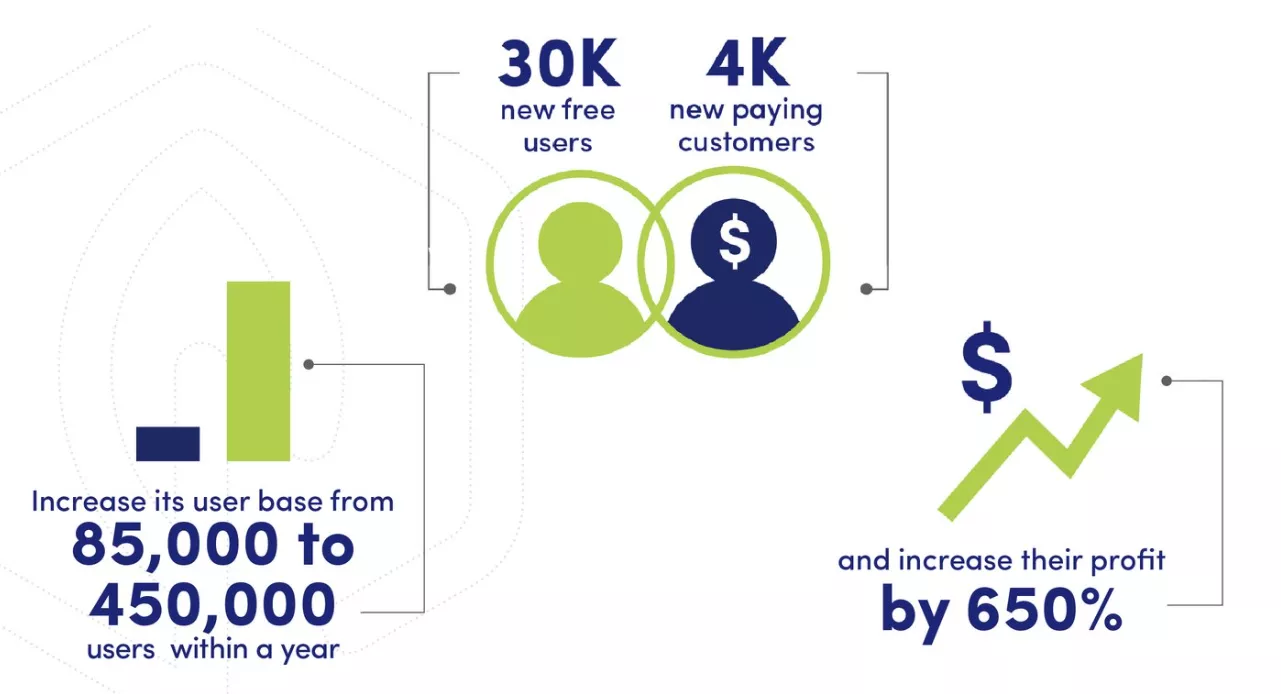
It’s worth noting the freemium concept fit with their brand and core ideals, too.
- They designed the freemium model with the customer in mind.
- This model targeted struggling / price-conscious small and medium-sized businesses to whom digital marketing was still a challenge.
- They offered essential features at no cost.
All this made it an attractive and accessible option for thousands (eventually millions) of users.
Takeaway
Freemium works extremely well if you structure it right. Free = no risk and low friction. For Mailchimp, freemium worked like rocket-fuel for growth because:
- The product was good and solved a problem (do not underestimate the importance of this).
- There was no payment barrier to trying it (but people were getting so much value that after a point, deciding to pay to get more value was a no-brainer).
- It spread like wildfire because each user was working indirectly to attract more users (“powered by Mailchimp link” at the bottom of every email).
A freemium option is powerful because it will drive many, many, many more people into your funnel to actually use your product or service.
And many of those who sign-up likely would not have used it otherwise.
Speaking of freemium, Growbo now has a new freemium option! You’ll get free access to useful resources like our Proven Sales Conversion Pack and you also get a free taste of what value our Done-For-You Marketing Team can… get Done-For-You .. Click Here To Learn More and Get Access.
Mailchimp Business Lesson #5: Loyalty Programs Are Like Free Money
Mailchimp’s tactical philosophy was to listen to their customers and give them what they want, right?
As from the previous lesson, we know people love free stuff. So this is why Mailchimp built a loyalty program inside its freemium model.
Here’s how their loyalty program works.
- Customers can add a referral badge to their emails and signup forms.
- After receiving a Mailchimp-delivered email people can click on this linked-badge. Then, they get redirected to Mailchimp. If the person signs up for a paid Mailchimp plan, both the referred and the new customer earn a $30 billing credit.
Simple and effective. (Mailchimp’s own words)
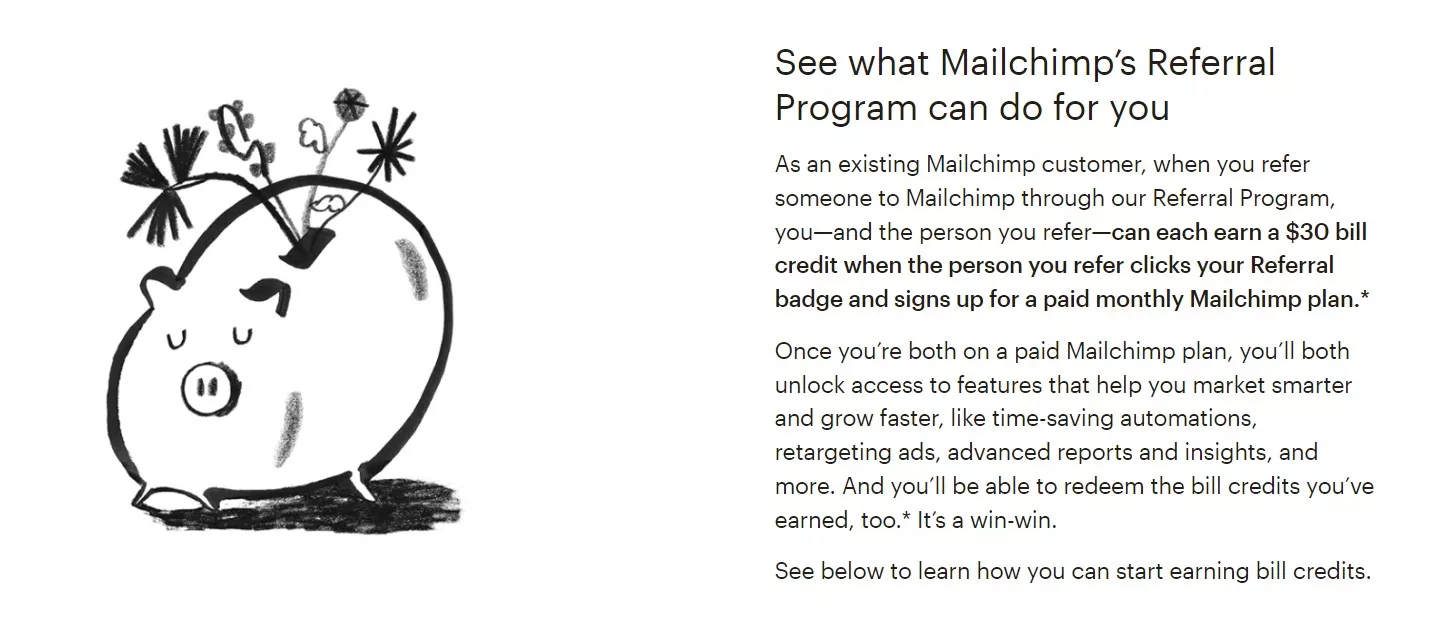
Consider that the most expensive part of marketing is finding new customers. It costs 6 times more to bring in new customers than it does to retain existing customers.
Loyalty programs take out the cost and hassle of finding new customers. They do the work for you. For very little cost, too. (In Mailchimp’s case, it’s a $30 bill credit. This means the person who signed up is still spending money.)
Takeaway
Offer a reward to your existing users / customers and let them bring new customers for you.
Put a rewards program in place to encourage your users to share your brand. They’ll do the heavy lifting of finding new customers for you.
Make your customers feel special and offer an incentive to promote your product.
Mailchimp Business Lesson #6: It’s OK To Pivot and Take A (Calculated) Risk
Ben Chestnut and Dan Kurzius, the founders of Mailchimp, were initially web developers. When they suddenly got laid off, at first, they stuck with what they knew—web design.
But sometimes you have to take a chance. So when Ben and Dan saw an opening in the market for email marketing, they decided to follow their gut and pivot. The result was Mailchimp.
And it wasn’t a simple decision at the time—it was a huge risk (but a calculated one).
Email marketing was nowhere near as popular back in 2007 as it is now. Spam emailing was out of control, and email marketing was in general associated with this.
Ben and Dan’s greatest challenge was convincing people that Mailchimp was different, that it would work, that it was worth paying for…

Fortunately for them, they were able to get around the spam problem and got traction in the market.
Mailchimp took another calculated risk when they went with the freemium model in 2009 (see lesson 4 above).
For the previous eight years, they had been testing different variations. Things like free trial vs. free services, and pay-as-you go vs. monthly subscriptions.
They had mountains of data (we’ll get more into that in lesson 9). The risk was indeed calculated. They knew they could still be profitable.
Giving away your services for free is always risky. But when Mailchimp introduced freemium to their customers their risk paid off. And today, its Forever Free is still in use.
Again these results they may not have been achieved had they not made this calculated decision:
- They grew their total user base by 5 times in a year (85,000 in September, 2009 to 450,000 in September, 2010).
- Most were freemium customers (they were adding 30,000 freemium users per month).
- But here’s the kicker: they were also adding 4,000 paying customers per month.
Two calculated risks and business pivots.
By themselves they did not = a $12 billion sale – but they were big contributors to that success.
Keep in mind, nothing is ever a sure thing. Even with all that data, it could’ve gone differently for Ben and Dan. That’s why it’s a calculated risk.
“It’s better to be directionally correct than absolutely correct.”
says entrepreneur Alex Hermosi.
Even if you don’t hit a home run, you’ll likely still be in the game, maybe score a single or double.
Either way, keep working at it, observing with open eyes, reflect, and take action again.
There are no silver bullets.
There is no secret.
Success means understanding that you’ve never truly arrived
Prove your product/ service works, has market traction, and then scales thru one or a number of calculated risks and micro pivots.
Just like Ben and Dan did.

Takeaway
Keep making changes, tweaks and full-on or micro-pivots until the data shows: “YES, this is what customers want”.
One way you can do this is A/B testing new ideas and then deciding based on your data.
At Growbo.com, your all-in-one team of marketing pros are ready to assist you with getting your digital marketing projects and tasks done—all you need to do is delegate. Start Your $7-for-7-Days Trial Now.
Mailchimp Business Lesson #7: Embrace Simplicity
Mailchimp has a secret weapon: simplicity. They’ve made their platform very easy to use. It has a clean design and straightforward features.
They’re not about looking cool; they’re about making their products accessible. This is why their products and services are easy to understand and simple to use.
Simple is best. Complicated means people get frustrated.
Studies show that bad user experience has lost $1.4 billion to businesses. Sometimes, one unpleasant experience is enough.
A bad experience may result in a canceled subscription. And, of course, a new customer to your competitors.
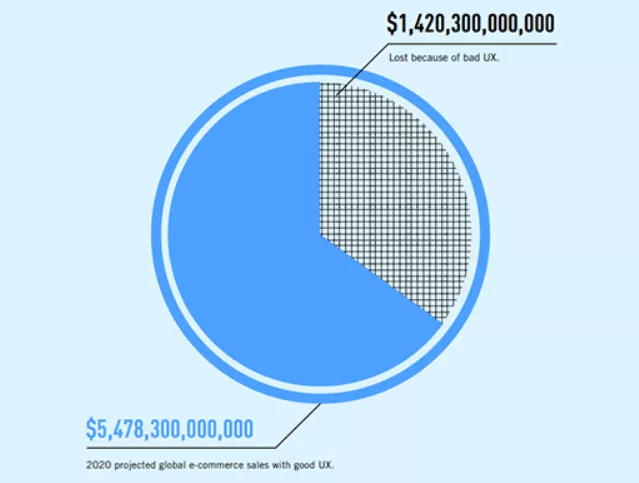
According to consumer behavior studies (and the 11 Laws of Sales Funnel Physics):
“People just love things that are easy to understand and use. They don’t want you to impress them with how smart you are”
Below is a screenshot of their UI.
Enough said…
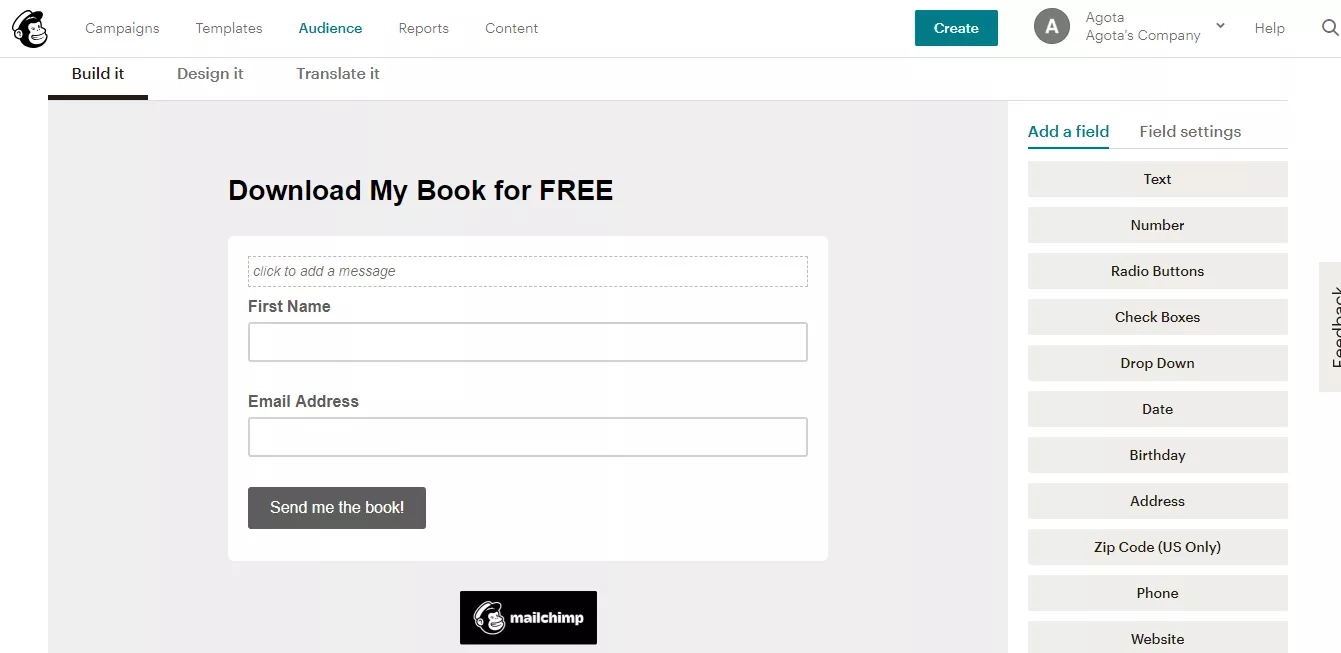
Takeaway
A smart, ambitious man once wrote me a letter. “Basic Ideas Prevail” he wrote.
That was my grandfather.
Keep your product / service, content, and your pricing simple.
People will get it, they’ll consume it faster, and decide to buy it and/or adopt it more easily into their business / workflow / life.
Example of this At Growbo:
We’re a big fan of the Hemingway Editor App.
We use Hemingway for our content and marketing. We run all our writing through it and keep editing until we get a grade 5 or 6 reading level.
The more people that can understand your content (and the less they have to “unpack it” while reading it (less friction), the more people will read, remember, benefit, and in turn, buy from you.
Here are a few quick Mailchimp-inspired tips to keep in mind for website copywriting simplicity.
- Keep sentences and paragraphs short and concise.
- Make sure your content aligns with your headline promise.
- Avoid technical language. Speak plainly.
- Put prices on your pricing page (you’d be surprised how many companies don’t).
- Use images instead of words when possible.
- Avoid clutter and aim for a good amount of white space.
Mailchimp Business Lesson #8: Don’t Stop. Keep Innovating, Keep Improving.
Mailchimp is all about making small, frequent updates to improve its platform.
And they don’t just do it to be flashier or make more money. They want to adapt to their customers’ needs and keep them happy.
Ben Chestnut believes in the power of new ideas. He says it’s important to write them down and keep them. People can quickly change their wants and needs, after all.
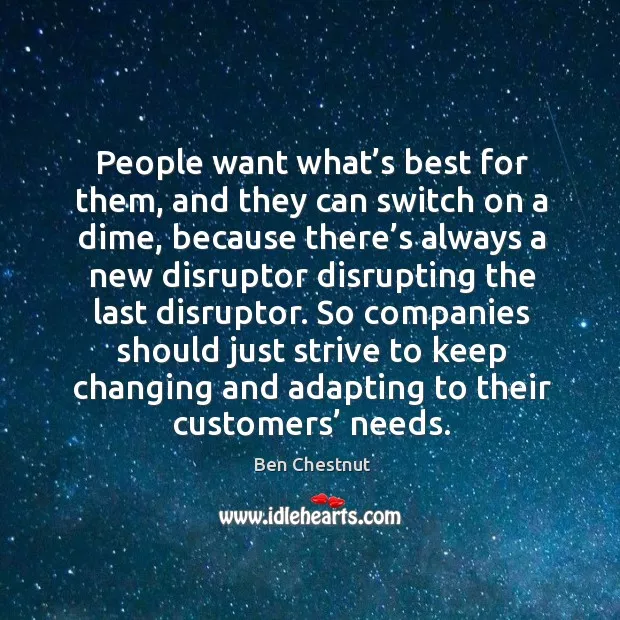
This approach has worked wonders for Mailchimp. They continue to earn the business of 1000’s of new customers signing up daily.
They could’ve stopped after the success of their freemium model. Or even after their massive sale to Intuit. But they didn’t.
They’ve now added AI, automations, analytics and more.

Founder Ben Chestnut still says there’s always more to do and new goals to achieve.
Takeaway
Continuous improvement is an absolute must (and one of Growbo’s core values). Try to keep your product fresh and relevant. This shows your customers that you're always striving to adapt and serve them better.
Mailchimp Business Lesson #9: Embrace Data-driven Decision Making
Today’s business decisions are all made with data. And why not? There’s a ton of it. Data (usually) points you in the right direction. You might as well reap the benefits.
Mailchimp was smart in this way from the very beginning.
For instance, they had tons of pricing data. This data helped when they were making their freemium pricing model decisions. They went through data from as far back as 2001.
Here’s what Ben Chestnut wrote in 2010 when reflecting on his then recent freemium success:
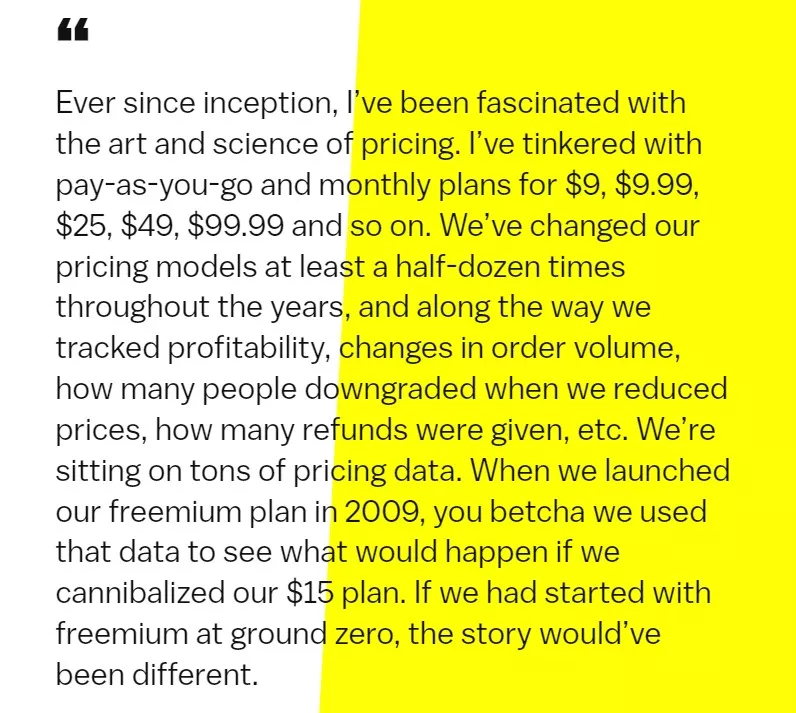
We’re going to be writing an article coming up about how you use AI to make better, smarter marketing decisions in regards to ads and your funnel. So subscribe to our newsletter if you aren’t already for that.
Takeaway
Data-driven decisions are your friend, because it helps to remove emotion, risk, and just plain guessing from decision-making.
Here are some free tools you might wish to consider to manage and track your data.
Conclusion
These lessons from Mailchimp will help grow your business. But so will delegating your marketing tasks and project to Growbo’s pros. Take the first step toward working less, and getting more of your marketing priorities done with an all-in-one team. Learn More and Start Your $7-for-7-Days Trial Now.
Here’s a quick recap of today’s article:
- Give the Customer What They Want: Listen to your customers, figure out how to “get close” to them as Mailchimp’s founders did so you can know and better meet their needs. Do this non-stop to out-compete everyone in your space.
- Find Your Niche First: Identify your target market. Focus on their specific requirements in your copy and how you design your product.
- Build an Unforgettable Brand: Create a unique and memorable brand identity to stand out in your market.
- Consider Launching a Freemium Version of Your Product / Service: Offer a free version of your product to attract tons of more users (leads)
- Everybody Wins With Loyalty Programs: Install loyalty programs to attract new customers. They share your product, get free stuff or $, and you get more leads and sales.
- Don’t Be Afraid To Take (Calculated) Risks: If you have to pivot, do it right. Study your data before making a risky choice.
- Embrace Simplicity: Keep everything simple and user-friendly. Your product, service, website, marketing, and everything else.
- Keep Innovating: Continually improve and update your product or service to stay competitive or risk customers jumping ship overtime.
- Leverage Data: Rely on data-driven decision-making to make better decisions and drive business growth0.
Follow these tips, and you could be on your way to a billion-dollar valuation, just like Mailchimp.
The key word there is “could.” Success is not guaranteed. But if you take action, your probability of success rises over time.
But with companies like Mailchimp showing us the way, growth is more accessible than ever.
Do you have some other business tips that you took from Mailchimp’s growth story? What are some other company growth stories you admire and why? I’d love to hear about it in the comments.
Until next time…
Keep Growin’, stay focused.

Image Bibliography
- https://robertkatai.com/mailchimp-using-creativity/
- https://www.casosexitosos.com/en/innovacion/caso-exito-mailchimp/
- https://tinyseed.com/latest/mailchimp-bootstrap-success#:~:text=Mailchimp%20became%20a%20unicorn%20in,their%20largest%20competitors%20ever%20could
- https://musebycl.io/advertising/mailchimp-unveils-playful-spots-directed-eric-wareheim
- https://robertkatai.com/mailchimp-using-creativity/
- https://www.bain.com/insights/are-you-experienced-infographic/
- https://mailchimp.com/referral-program/
- https://www.cbinsights.com/research/report/startup-failure-reasons-top/
- https://www.emailtooltester.com/en/blog/mailchimp-market-share/#big
- https://www.drift.com/blog/how-mailchimp-grew/
- https://robertkatai.com/mailchimp-using-creativity/
- https://www.idlehearts.com/623931/people-want-whats-best-for-them-and-they-can-switch-on
- https://medium.com/sodio-tech/is-pivoting-the-business-model-of-your-startup-a-great-idea-f7498316146
- https://tinyseed.com/latest/mailchimp-bootstrap-success
- https://www.bain.com/insights/are-you-experienced-infographic/
- https://www.gallup.com/workplace/229832/culture.aspx
- https://jelvix.com/blog/data-driven-decision-making













